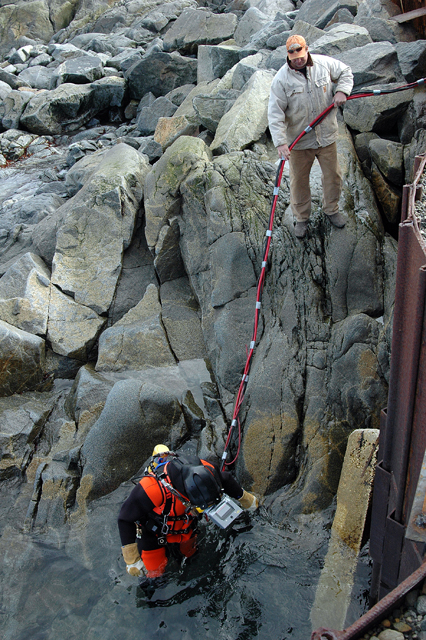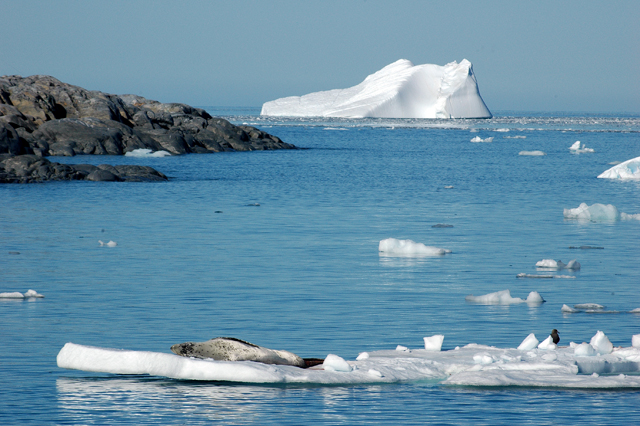Pier pressureDivers make repairs to Palmer Station's aging wharfPosted January 22, 2010
Underwater images of Antarctica often show an unearthly realm of gigantic sponges, alien jellyfish, and Adélie penguins shooting through the water like bulbous bullets. Divers Rob Robbins, Steve Rupp and Travis Matoush don’t see much of that. The trio is at Palmer Station More Information
This is the second year in a row that divers have visited the station during the Antarctic summer, spending long hours underwater welding steel plates and angles onto the seams to help hold the pier together and stop the sinkholes from forming. “It looked like Swiss cheese. There were holes everywhere,” said diver Steve Rupp of the condition of the pier when he saw it during the 2008-09 field season, after helping with some of the first repairs about 15 years ago. Built in 1967 by U.S. Navy Seabees, the pier is well past its estimated lifetime. Eventually, it will need to be replaced or undergo extensive rehabilitation — a costly and intensive operation for the smallest of the U.S. Antarctic Program’s The pier primarily accommodates the ARSV Laurence M. Gould The divers are attempting to make as many repairs as possible over the few weeks they’re at the station, working six days a week, rotating one person into the water each morning and afternoon. It’s certainly different from your typical recreational dive. A small compressor on the surface helps supply air to the diver under the water, a bundle of hoses snaking from the pier down a steep, sharp decline of rocks. A team member monitors the air supply within an ad hoc dive center staged in a cargo container on the pier. A big switch topside turns the welder on or off whenever the diver calls out “hot” or “cold” through a communications link. The channel is always open, so the diver’s breathing sounds like Darth Vader is lingering nearby. The divers use bulky, loose wet suits rather than dry suits for their underwater welding work. Seawater is pumped through a hotwater heater that runs through a tube into the wetsuit, supplying a constant stream of about 105-degree Fahrenheit water. The hotwater can sometimes make it uncomfortably hot in the 35-degree inlet. “We’re trying to have these really long dives, to be as efficient as possible, so we’re using hotwater suits,” explained diver Rob Robbins. Robbins and Rupp — both dive supervisors for Raytheon Polar Services Company “It’s definitely helped us — especially a small team like this — when we put a guy in the morning or a guy in the afternoon, we can get a lot done without having to switch out divers every hour,” Rupp said while Matoush was doing his first-ever Antarctic dive and learning the subtleties of welding underwater. “It’s tougher,” Rupp said of melting metals together in the wet and cold. “One of the problems is that there are so many bubbles and so much stuff coming off the weld that you have a hard time seeing the actual weld puddle. A lot of it is feel.” In addition to reinforcing the pier’s deteriorating armor with more metal, the divers add zinc over their welds. The zinc acts as a sacrificial anode, which protects the metal underneath because zinc more easily oxidizes, and so it will corrode first. The divers lock carabineers into heavy-duty magnets to anchor themselves to the pier, using whatever angle they can contort their bodies into to find the necessary leverage to zap the metal onto the pockmarked surface. They work from just below the water surface to the deepest part of the pier, about 24 feet. “The surge makes it really hard to stay steady,” Robbins noted. The work draws the occasionally curious station resident to the pier to check out the operation, the diver shallow enough to be visible from above the water. Flashes from welder provide a strobe effect. A leopard seal, one of the top Antarctic predators in the region, lounges on a nearby ice floe, thankfully uninterested in the weird human activity. That wasn’t the case last year when Robbins was in the water. An unexpected bump pushed him into the pier, as the story goes. Robbins just assumed it was one of the ubiquitous bergy bits of ice that float around the harbor. “I went to push it away, and it was a leopard seal,” he said. “They’re scary, there’s no doubt about that. They swim a lot better than I do.” The work rarely gets that exciting, though the divers say they enjoy the job, a break from the science diving they normally support at McMurdo Station Rebecca Shoop appreciates the long, cold hours the team has devoted to making the pier safer. “Once those guys came down last year to patch the holes, we haven’t had any problems with sink holes,” said Shoop, the Palmer Area manager.
|



For USAP Participants |
For The Public |
For Researchers and EducatorsContact UsU.S. National Science FoundationOffice of Polar Programs Geosciences Directorate 2415 Eisenhower Avenue, Suite W7100 Alexandria, VA 22314 Sign up for the NSF Office of Polar Programs newsletter and events. Feedback Form |







